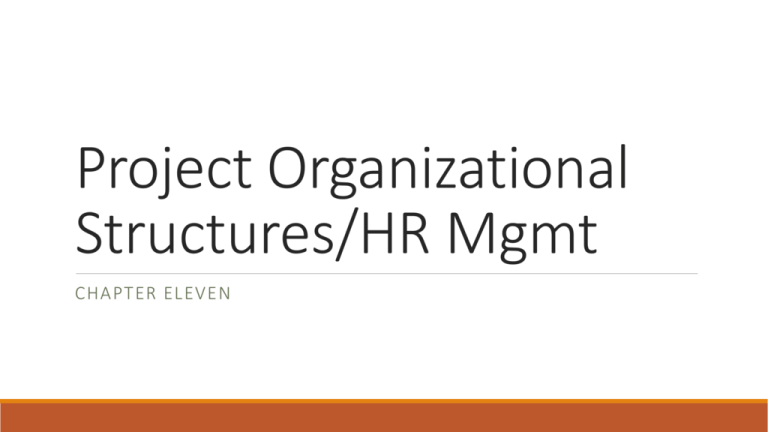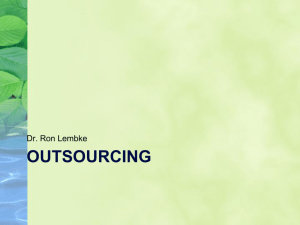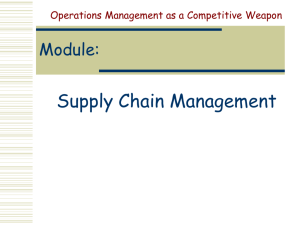Project Organizational Structures/HR Mgmt
advertisement

Project Organizational Structures/HR Mgmt CHAPTER ELEVEN Learning Objectives Define authority, reliability, responsibility, and accountability in projects Identify, define, and organize the five organizational structures Design projects aligned with organizational strategy Work with the project management office, and understand how PMOs function Discuss general policies and procedures of PM Understand individuals and project team roles and build project teams Understand the risks, and manage outsourcing projects Fayol’s principles of management Project manager needs authority to give orders and power to exact obedience in order to manage projects successfully Project manager needs the discipline not to misuse the authority and power. The interest of any one individual employee shall not supersede the entire organization’s interests Fair pay and rewards for rendered services All materials and people must be in appointed places for a project Fair and equal treatment amongst team members and project managers A stable project team with no or very limited turnover of personnel Harmony and union among personnel 4 legged chair of organizational structure Authority is a manager’s right to make decisions, issue orders, and allocate resources to achieve desired outcome. Accountability in organizations deals with the reporting and justification of the project outcomes to superiors. Reliability is the degree to which a project team member can be depended upon to ensure the success of the project with a sound and consistent effort. Responsibility is less formal and is an externally imposed duty with a felt sense of obligation. Authority Formal Authority Legitimacy Legal Legal order Social approval Functional Authority Position Competence Hierarchical office Rational authority Formally Technical conferred knowledge and Authority of expertise sanctions Experience Role incumbency Specialized skills Formal role or Authority of position confidence Knowledge of performance criteria Person Traditional authority Charismatic Conferred by seniority or popularity Techniques of persuasion Knowledge of human aspect of administration Rapport with subordinates Ability to mediate individual needs Types of Organizational Structure Organizations can be classified into five major structures: • Functional structure • Departmental structure • Matrix structure • Flat structure • Virtual structure Functional Structure Matrix Structure Weak, Strong, and Balanced Matrix: Functional, Project, and Both Flat Structure A flat structure is common in professional organizations like law firms, consulting firms, entrepreneurial start-ups, and small companies in general. As the company grows, however, the organization becomes more complex and hierarchical, which leads to an expanded structure, with more levels and departments. A flat project organization has few or no levels of intervening management between staff and managers. Virtual Structure A virtual organization is a temporary network or loose coalition of people who come together for a specific business purpose and then disassemble when the purpose has been met. “Virtual” originates from the virtual memory of computers, the ability to appear to have more storage capacity than it actually has. Matrix Structure Form Function Project Determinants • • • • • • • • When efficiency is the first criterion When competitive advantage is along a single parameter like technology, price, performance, or delivery When markets are relatively predictable When range of products with long time horizons is projected When several simultaneous success criteria like performance, cost, schedule, technology, and efficiency are considered When moderate market changes are expected When there are many different clients, markets, products, or projects When there is specified time for each client or project When and What Matrix Structure Should be Used? Factors Favors Functional Favors Dept. Structure Structure Favors Matrix Structure Uncertainty Complexity Duration Size Importance Customer Interdependency from within Structure Interdependency between Structure Time Criticality Differentiation Low Low Short Small Low Diverse Low High Medium Medium Medium Medium Medium Medium High High Long Large High One High High Medium Low Low Low Medium High High Medium Organizational and Project Strategy Projects in an organization have to be strategized and the organizational strategies have to be aligned with those project strategies Project Management Office Many organizations are moving in the direction of establishing PMOs or have already done so. There is strong evidence that PM standards and methods are most highly correlated with project performance. The use of project historical archives also showed a significant correlation with project performance. Pioneers in establishing PMOs are providing information and advice on essential policies and documents that should accompany the establishment and use of a PMO. Main Function Areas of PMO’s •Project support: Provide project management guidance to project managers in business units •Project management process/methodology: Develop and implement a consistent and standardized process •Training: Conduct training programs or collect requirements for an outside company •Home for project managers: Maintain a centralized office from which project managers are loaned out to work on projects •Internal consulting and mentoring: Advise employees about best practices •Project management software tools: Select and maintain project management tools for use by employees •Portfolio management: Establish a staff of program managers who can manage multiple projects that are related, such as infrastructure technologies, desktop applications and so on, and allocate resources accordingly •Project Control: Establish control processes and monitor projects Comparison between PMO and Center of Excellence Policies and Procedures •Policies reflect the "rules" governing the implementation of the project management processes. •Procedures, on the other hand, represent an implementation of policy and should evolve over time as new tools emerge, new processes are designed, and the risks associated with an area changes in response to internal or external environmental changes. •Project organizations need to challenge outdated procedures and revise them as and when needed. •The general policies and procedures as well as guidelines need to be in a document that is accessible to all stakeholders of a project. General Policies •Policy 1: Establish Organizational Objectives •Policy 2: Include Project Responsibilities in Job Descriptions •Policy 3: Increase Use of Team-Based Performance Reviews •Policy 4: Establish Career Paths for Program and Project Personnel •Policy 5: Organize Programs Into Projects and Subprojects •Policy 6: Prioritize Using Project Inventories •Policy 7: Optimize Personnel Resources •Policy 8: Coordinate Intergroup Transitions Roles and Responsibilities Role Project Manager Responsibility Plan and schedule activities Coordinate all activities Control success factors Measure all project metrics Skills Needed Planning Coordination Managing activities Conflict resolution Leadership People skills Project Advisor Understand technology and business Analyze project requirements and select activities based on facts Technical expertise Business acumen Assessing trade-offs Decision making Excellent communications Negotiation Leadership People skills Project Communicator Communicate with all stakeholders Report to stakeholders Negotiate with contractors and vendors Project Team Roles Group task roles • Team member roles are related to their project. Their purpose is to facilitate and coordinate team effort in the selection, definition, and solution to the problem of the project. Group building and maintenance roles • The roles in this classification are oriented towards the function of the team. The roles can alter or maintain the team way of working to strengthen, regulate, and perpetuate the team as a team. Individual roles • This classification of roles is directed towards the satisfaction of individual needs of each of the team members. Individual team members with their own goals not relevant to the project tasks are relevant to the problem of group dynamics, training, and improving team maturity and project efficiency. Group Task Roles •Initiator-Contributor •Coordinator •Information Seeker •Orienter •Opinion Seeker •Evaluator-Critic •Information Giver •Energizer •Opinion Giver •Procedural Technician •Elaborator Group building and maintenance roles Encourager Harmonizer Compromiser Gatekeeper-Expediter Standard setter or ego ideal Observer-Commentator Follower Individual Roles •Aggressor •Blocker •Recognition Seeker •Self-confessor •Playboy/Playgirl •Dominator •Help Seeker •Special Interest Pleader Category Objectives Project Outcome Authority, Reliability, Responsibility, and Accountability Resources Teamwork Factors of effective team building • • • • • • • • • Purpose of project Expectations of stakeholders Expected results and outcome Tools and techniques to be used to obtain results Metrics and measurements Methods of measuring the metrics Authority and accountability structure Organizational structure Responsibility matrix • • • • • • • • • • • • Required expertise Required skills Required technology Required consultants and contractors Mentorship Rewards and recognition Expectations of each team member Decision-making process Tools for effective consensus building Effective technology transfer Learning Effective communications Four stages in the project lifespan: • Forming • Storming • Norming • Performing Outsourcing •Offshoring is the process of outsourcing a project to another country which is outside of the country and usually to a location off the shores of the country. •Nearshoring is the process of outsourcing a project to another company in a nearby location, state or country that shares a border with the country with the outsourcing organization. •Insourcing is when a business unit does not have certain skills and so uses the skills from other departments internal to the organization. •Cosourcing in a project is a practice when the project is performed by internal staff of an organization and also by an external contractor. It is often advantageous to an organization as it minimizes outsourcing risks and brings control over the outsourced project. •Multisourcing is a new outsourcing model that reaches out to bring multiple sources from both inside and outside an organization. For example, ABN AMRO is partnered with three different Indian companies Infosys, Patni and TCS along with two American companies Accenture and IBM. 3 Dimensions of Outsourcing Maturity in Outsourcing Best Practices of Outsourcing •Selection of projects •Personnel issues •Selection of outsourcing company •Knowledge transfer •Project requirements •Conflict management •Delivery and documentation of projects •Communication management •Hidden costs •Relationships •Project control •Contracts and Exit strategy






